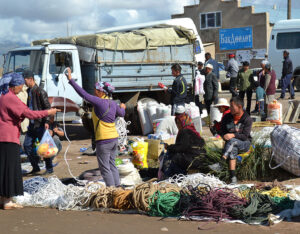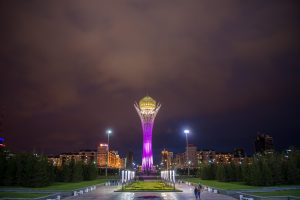Стратегические водные ресурсы Центральной Азии: в поисках нового международного правового порядка

Introduction
The allocation and use of the water resources of Central Asia is one of the most difficult issues to arise out of the break-up of the Soviet Union. In outline the question is simple: how should the waters of the great Central Asian rivers, the Syr Darya and Amu Darya, be used? To generate much-needed hydropower electricity in the mountainous countries in which they rise? Or for irrigation in the energy-rich downstream countries? Added into the mix is the fact that due largely to over-use for irrigation, both rivers flow (notionally, at least) into the depleted wastes of the environmental disaster that is the Aral Sea.
In Soviet times the situation was simple: major decisions were made by Moscow. Independence changed that. Now, beyond the issue of how the existing Soviet-era infrastructure should be operated (for irrigation or hydropower), tensions are rising over the proposed construction of significant new hydropower projects in the upstream countries. Indeed water issues are seen to pose a significant threat to regional security. In February 2009 Uzbekistan’s President Karimov told his cabinet that country’s water was under threat and invoked the need to safeguard the interests of future generations of Uzbeks.(1)
As the European Union (EU) noted in 2008, water management is the most sensitive environmental issue in Central Asia, which, if not addressed, could develop into a serious security threat for the entire region in the medium term. These observations(2), which were contained in a joint progress report on the EU’s Central Asia Strategy, appear to be coming true: at the time of writing, freight traffic delays on the Uzbekistan side of the Uzbek-Tajik threaten to inflict serious damage to the already troubled Tajik economy, as well as to cause disruption to an important supply route used by US and NATO troops in Afghanistan.(3)
The aim of this paper is to describe the basic problem and the efforts undertaken both by the Central Asian States and the international community, including the EU, to seek a resolution. It traces recent developments relating to the planned construction of dams, the modification of energy supplies and the periodic issue of increasingly bellicose statements from the capitals in the region. Finally it looks into the challenge for establishing a modern international legal order to govern the region’s strategic water resources.
The shared rivers of Central Asia
Both the Amu Darya and the Syr Darya are trans-boundary watercourses. The Amu Darya River is formed in Tajikistan from two tributaries, the Vaksh River which rises in Tajikistan (although one of its tributaries the Kyzleu River flows into Tajikistan from Kyrgyzstan) and the Pyanch River which rises in Tajikistan but which forms part of Tajikistan’s border with Afghanistan. Thereafter it flows through Turkmenistan and Uzbekistan before terminating in the Aral Sea.
The Syr Darya is formed from two tributaries, the Naryn River and the Kara Darya both of which rise in the Kyrgyzstan. Thereafter it flows through Uzbekistan, Tajikistan and Kazakhstan before also terminating in the Aral Sea.
Although the largest, the Amu Darya and Syr Darya are not the only shared rivers of Central Asia. The Chui and Talas Rivers are shared between Kyrgyzstan and Kazakhstan while a number of smaller rivers flow from Kyrgyzstan into China. Conversely the Irtush and Illy Rivers flow from China into Kazakhstan, with the Irtush continuing into Russia.
Soviet experience
During the Soviet period, Central Asia was treated as one economic area and its development was planned accordingly. In turn, water management was focused on achieving the production objectives of the overall regional economic development plan.
Regarding the Aral Basin, decisions were made in Moscow in the 1960s to focus on the development of cotton production in the Uzbek Soviet Socialist Republic, and subsequently on rice production in the Kazakh Soviet Socialist Republic, with a view to achieving self-sufficiency in these products. Major investments were made in the construction of dams, reservoirs, canals and other hydro-structures to promote and manage the transfer of water from its sources in the mountains of the Kyrgyz and Tajik republics to the main growing areas fed by massive irrigation schemes in Uzbek and Kazakh republics.
The borders between the separate soviet socialist republics (SSR), which in many ways were little more than administrative boundaries within the Soviet Union, were effectively disregarded in the construction process. Irrigation canals, such as the South Fergana Canal, passed through several SSRs. Dams and other hydro-structures were built in one SSR to benefit crop production in another, either partially or wholly. Perhaps the clearest example is the Toktogul Reservoir. With a total volume of 19 billion cubic metres it was formed on the Naryn River in the Kyrgyz SSR flooding a large area of valuable arable land in the process. Although the series of dams that form the Toktogul Cascade are ‘dual purpose’ in the sense that the impounded water is used for both irrigation and hydropower generation, only a tiny fraction of this water was capable of being used for irrigation in the Kyrgyz SSR. The remainder was conveyed by canal to irrigate fields in the downstream republics.
Furthermore, the development of potentially irrigable land in the upstream republics was sometimes deliberately restricted so as to make more water available for the development of valuable new agricultural areas downstream.
Nevertheless, soviet planners and decision-makers did take account of the valuable role of the upstream republics as the formation zone for Central Asia’s rivers. The costs of water management within the upstream republics were paid or subsidized from Soviet central funds. These included the costs of water resource monitoring and data collection as well as the operation of inter-state irrigation canals. It also included the costs of constructing and maintaining flood protection infrastructure such as embankments and dikes as well as the costs of afforestation and the remediation of damage caused by floods, landslides and mud-floods.
In addition, the upstream republics received other benefits such as the provision of cheap fuel and electricity as well as social benefits to take account of their relative poverty as mountain regions within the USSR. In other words, even though the development of water resources infrastructure within the upstream republics was restricted, their contribution to the development of the greater Central Asian, or even Soviet, economy was recognized and compensated.
However, although Moscow treated the Central Asian soviet republics as one economic area, this does not mean that there was not competition among the SSRs for water. Each of the republics sought to maximize its entitlements to water resources at the expense of the others. During the Soviet period, the issue of water sharing among the Central Asian soviet republics was considered in detail on three occasions, the last time in the early 1980s. While negotiations and discussions took place between the republics themselves, the Soviet Ministry of Amelioration and Water Resources in Moscow coordinated the process. Final decisions on water allocation were made in Moscow, either by the Soviet Ministry or the Soviet Central Planning Agency (Gosplan) or on some occasions by the Central Committee of the Soviet Communist Party. Water resource allocations were then formally recorded in a series of bilateral or multilateral protocols between the soviet republics.
In addition, in 1986 ‘River Basin Organizations’ (the Russian acronyms for which are ‘BVO’) were established for the Syr Darya and Amy Darya rivers to improve the management of water resources that were the subject of agreements between more than two soviet republics. The BVOs were also given responsibilities for the operation of certain major dams and diversion structures. However, the Syr Darya BVO had less impact on water resource management in the Kyrgyz SSR than in the downstream soviet republics. In part this is because the Kyrgyz SSR refused, to the extent possible, to cooperate with the BVO, seeing it as a mechanism for the downstream soviet republics to increase their control over ‘its’ water resources.
In any event, the net result of the water sharing arrangements was that at the end of the Soviet era, the upstream soviet republics was entitled to use only a fraction of the water formed annually within their territories. The Kyrgyz SSR was, for example, obliged to allow some 76 percent of the water that rose within its borders to flow downstream into the neighbouring republics.
Independence and its impacts
The independence of the five Central Asian States in 1991 changed everything in terms of water resources management. Administrative boundaries became international borders and the Aral Sea Basin became an international drainage basin subject to the rules of international law, or more specifically, international water course law.
At the same time nothing changed. The rivers continued to flow, the infrastructure remained in place, the need for water was not changed, albeit that some of the larger canals were now ‘trans- boundary canals’ (possibly a new concept in international law). From a purely technical point of view the design of the canals, dams and other hydraulic works meant that a high degree of routine cooperation between the new countries was necessary to keep the systems in operation.
Consequently, questions of water use and water sharing were among the first to be confronted by the new Central Asian states. Straightaway, a further challenge arose. International law was not a strength of the newly independent states of Central Asia. This is hardly surprising as Soviet foreign policy was made in Moscow and the need for international law, and international lawyers, in the region was slight.
The first major attempt to consider the matter at a high level was at an inter-ministerial meeting in Almaty in February 1992. The outcome of this meeting was the Almaty Agreement On Joint Management of Water Resources of 18 February 1992, which affirmed the Soviet-era water sharing arrangements. The fact that this agreement was signed by the ministers responsible for water resources in their respective countries, rather than by government level delegations, has led some to question its validity. The agreement also led to the establishment of the ‘Inter-state Co- ordination of Water Resources Commission’ (the ‘ICWC’) which is responsible for the allocation of water in respect of canals and structures canals controlled by the BVOs which remain in place.
A number of other regional agreements followed, many of which focused on the Aral Sea. These were followed by agreements concerning the use and allocation of the waters of the Syr Darya and Amu Darya. One of these was the Agreement between the Governments of the Republic of Kazakhstan, the Kyrgyz Republic and the Republic of Uzbekistan on the Use of Water and Energy Resources in the Syr Darya Basin of 1998. This sought to provide a framework for the operation of the Toktogul Hydropower Cascade. As Kyrgyzstan can receive very little irrigation water from Toktogul Reservoir, Kyrgyz interests are best served by an operating regime that keeps the sluice gates closed in spring and summer and releases water to generate electricity during the winter months. However, the spring and summer are precisely the seasons when Kazakhstan and Uzbekistan need water for irrigation. Furthermore, releases of water in the winter months pose a serious flood risk in Uzbekistan when the Syr Darya freezes. The 1998 agreement provided for the conclusion of annual agreements regarding the release of water from the Toktogul Cascade and compensatory payments to the Kyrgyzstan for its ‘lost’ opportunity to generate electricity in the winter months in the form of energy resources such as oil, coal, gas and electricity or other products or money. In addition, the downstream states agreed to purchase electricity generated during the summer releases that was surplus to Kyrgyz requirements.
Subsequently a series of annual barter agreements have been reached between the Central Asian States, including with Tajikistan, that have broadly the same approach. Unfortunately they have had a rather poor record of success. More bluntly for one reason or other the agreements have often been breached. ‘Technical’ and other problems have arisen with gas and coal supplies meaning that the upstream countries have been left without light and heat. Arguments have arisen over the value of the goods exchanged. Agreed water release schedules have not always been complied with, sometimes as a direct result of the failure of downstream States to supply energy: The upstream States have felt obliged to release greater quantities of water during the winter months to generate hydropower electricity to keep their respective populations warm.
The most recent agreement was signed in October 2008 by Kazakhstan, Kyrgyzstan and Tajikistan and provided for reciprocal supplies of water, oil and coal. However the abstention of Uzbekistan has made the agreement impracticable: the country uses a high proportion of the river water originating in Tajikistan and Kyrgyzstan is the main supplier of gas to those countries.
Meanwhile the river basin organizations still exist, the ICWC is still there, but they do not play much of a meaningful role in terms of water allocation.
In any event, what none of these agreements have done is to resolve in any meaningful manner the basic question of water allocation in Central Asia. So far the basis for the use and sharing of water remains basically the Soviet water sharing rules as acknowledged, or not, in the Almaty Agreement. The rights claimed by the upstream countries to compensation for allowing water to flow as well as the costs of maintaining the upstream water bodies have been strenuously resisted by the downstream states, particularly Uzbekistan. Tensions flared following the adoption by the Kyrgyz parliament in 2001 of Law on interstate use of water objects, water resources and water economy constructions which provided that Kyrgyz water would be supplied to downstream countries on a ‘paid’ basis.. And Uzbekistan, and to a lesser extent Kazakhstan, has strenuously opposed all attempts to equate its natural resources, in the form of gas and hydrocarbons, with the natural resources of the upstream states: water.
The withdrawal of Uzbekistan and Kazakhstan at the end of 2009 from the regional electricity grid appears to reduce the scope for its participation in future barter agreements. However notwithstanding the tensions caused by disputes regarding the implementation of these agreements, they have been largely implemented around soviet-era infrastructure. The rights of the upstream and downstream states, in terms of water use and water allocation, remains unresolved but the situation has essentially been one of status quo. It is the construction of new infrastructure, in the form of new hydropower dams by the upstream countries that threatens to substantially increase tensions and the risk to regional security. This is where the arguments threaten to become serious. But what exactly are the legal rights of the riparian states?
What does international watercourse law say?
International law is the body of law that regulates the rights and duties of states and other actors, such as international organizations that are recognized by international law. International watercourse law is the branch of international law that is concerned with the use and protection of trans-boundary watercourses. The sources of international watercourse law are identical to those of international law in general, namely agreements (treaties, conventions), both directly and indirectly through decisions of intergovernmental organizations given binding force by treaty, and customary international law.
However, unlike, other important environmental resources, such as biodiversity or the world’s oceans, there is no currently no global framework agreement in force that regulates the use of shared water resources.
A draft instrument, in the form of the Convention on the Law of the Non-navigational Uses of International Watercourses (the ‘Watercourse Convention’), was adopted by a vote of the United Nations General Assembly on 21 May 1997. However it is has not entered into force and it is quite possible that it never will. The result is that international watercourse law, and thus the rights and duties of the Central Asian States over the great shared rivers, is governed by customary international law.
Nevertheless certain key elements of the Watercourse Convention are commonly held to be declaratory of customary international law. In outline, these include: (a) the requirement, contained in Article 5 of the Watercourse Convention that ‘watercourse states’ in their respective territories utilize an international water course in an ‘equitable and reasonable manner’; (b) the duty of water course states to take all appropriate measures to prevent the causing of significant harm to other watercourse states, set in Article 7 of the Watercourse Convention; and (c) a range of duties of water course states to cooperate (Article 8), to notify and to consult on planned measures and if such consultations do not reach a satisfactory outcome to negotiate in a meaningful way (Articles 11 to 17).(4)
However, while it is relatively easy to summarize what international law says about the use of international courses, applying these principles is more difficult. How, for example, to determine what is equitable and reasonable? The Watercourse Convention tries to assist. It calls for ‘all relevant factors and circumstances’ to be taken into account including:
- a) geographic, hydrographic, hydrological, climatic, ecological and other factors of a natural character;
- b) the social and economic needs of the watercourse States
concerned; - c) the population dependent on the watercourse in each wa- tercourse State;
- d) the effects of the use or uses of the watercourses in one
watercourse State on other watercourse States; - e) existing and potential uses of the watercourse;
- f) conservation, protection, development and economy of use of the water resources of the watercourse and the costs of measures taken to that effect;
- g) the availability of alternatives, of comparable value, to a par- ticular planned or existing use.
But in practice while these factors offer some guidance they leave many questions as to how the issue of ‘equitable and reasonable’ use should be applied in Central Asia, as elsewhere. For example, the downstream countries have a greater population dependent on the shared rivers than the upstream States does this mean that they are entitled to a proportionately greater share of water? On the other hand the social and economic needs of the (poorer) upstream States are arguably greater. Should a distinction be drawn between the use of water for food crops and cash crops? What of the conservation argument? Uzbekistan, which has ratified the Watercourse Convention, has argued that the construction of new dams will further reduce flows into the Aral Sea and that new dams should be opposed on environmental grounds. But on the other hand much of the destruction of that sea has been caused by overwatering cotton crops of the downstream States. In short, what is ‘equitable and reasonable’ use? And how can the notion of equitable and reasonable use be reconciled with the duty not to cause significant harm to downstream States? And in any event what level of harm is ‘significant’.
The Watercourse Convention goes on to provide, in Article 11, that in the absence of agreement or custom to the contrary, no use of an international watercourse enjoys inherent priority over other uses. The only other guidance is that special regard must be given to the ‘requirements of vital human needs’ although this notion is not further developed.
A full discussion of these issues is far beyond the scope of this paper.(5) Suffice it to say that international law does not provide clear answers to these issues (or indeed a number of other specific issues such as the rights and duties of the Central Asian States over the trans-boundary canals).
What is tolerably clear is that the upstream countries cannot simply do as they like. The notion of full upstream sovereignty, the so-called ‘Harmon doctrine’, is not good law. More specifically they are under a duty to inform the downstream States before undertaking planned measures, such as the construction of dams, to notify and consult with them and to negotiate in a meaningful way if consultations do not lead to agreement. But by the same token, there is no downstream veto either: if no agreement can be reached, provided the upstream States have genuinely sought to negotiate, the downstream States appear to enjoy no veto per se on future upstream measures.
In short, international law offers no simple solution to the complexities of the use of the shared waters of Central Asia. Ultimately the question of what amounts to the equitable and reasonable use of the Syr Darya and Amu Darya Rivers can be resolved in two ways: by negotiation among the parties or by an independent court or tribunal. It is no doubt partly because the issue is so difficult to resolve, and so fraught with the risk that a ‘mistake’ might be made, that the authoritarian rulers of Central Asia have shied away from reaching an definitive resolution in the form of a negotiated agreement. After all once an agreement is reached sovereignty over the water is effectively determined for good. The degree of complexity means that there is endless scope for second guessing outcomes. No Central Asian President wants to be criticized as the person who signed away part of his country’s sovereignty, who didn’t ‘get a good deal’, who didn’t ‘win’, who didn’t ‘get one over on the neighbours’.(6)
In these circumstances the status quo, however uncomfortable it may sometimes be, probably seems to be the ‘safest’ solution. Of course population growth and climate change will sooner or later impact the Central Asia’s rivers, but all else being equal these are problems that can best be left for the future. The problem, though, is that all else is no longer equal given planned new dam construction. In other words the status quo is no longer feasible.
International community
Since the point when disputes over water in the region became ‘international’ with the independence of the five Central Asian States, the international community has in turn been rather active in terms of water issues in the region. The primary response has been largely through numerous development/technical assistance projects focusing on a range of water and water related issues. Indeed the region has been subject to a flood of such projects, doused with an alphabet soup of donor agencies and their project acronyms.
All of the major multilateral donors have been involved in water projects including the World Bank, the Global Environment Facility (GEF), various United Nations Agencies and bodies including the United Nations Environment Programme (UNEP), the United Nations Development Program the Food and Agriculture Organization (FAO), and the United Nations economic commissions for Europe and Asia (UNECE and UNESCAP). In addition to the EU numerous bilateral donors have also been involved including the United States Agency for International Development (USAID), the German GTZ, Britain’s Department for International Development (DFID), Swiss Cooperation, Canada’s CIDA, and so on. Projects have also been promoted by the International Water Management Institute (IWMI) and the Global Water Partnership (GWP).
Many projects have, of course been undertaken at the purely national dealing with irrigation, drinking water supply and national policy programs. However quite a number of projects have been regional in scope. Some, particularly those supported by the GEF and a number of World Bank projects, have been focused on the problems of the Aral Sea. Others, including projects funded by USAID, have explicitly specifically sought to develop and realize solutions to the main trans-boundary water issues in Central Asia. It is of course beyond the scope of this paper to review all of these projects. Some of the earlier EU projects, such as the Water Resources Management and Agricultural Production Project (WARMAP) included an element with a particular focus on international issues even discussing draft agreements and providing (much needed) advice on international water law.
Suffice it to say that such projects have not been effective. In retrospect it is not surprising that these attempts failed. Of course there was and probably is still a need for training and capacity building but the problem is that projects take place at the level of senior officials. Even when ministers participate there are always limits as to what can be achieved within a technical assistance project unless there is sufficient political will. And as described in the previous section, that political will has been lacking.
Moving from directly addressing the issue of water sharing and water use, a series of subsequent EU projects have addressed integrated water resource management (IWRM) and now ‘water governance’. The idea is that by working at the basin or sub-basin level looking at national coordination a model of cooperation can be developed. Several comments though need to be made. First of all Uzbekistan has marginalized itself from these multinational projects (and a recent attempt to revive trans-boundary cooperation by bringing groundwater into the equation failed with the cancellation of a proposed project examining transboundary conjunctive ie surface and groundwater use). Second, the current EU Water Governance Project is largely focused on water quality issues, which are in turn the main focus of EU water law. No doubt important, addressing these questions is almost entirely irrelevant to the main issue of the sharing and allocation of water resources. Dialogues have been held under the EU Water Initiative but these two are mostly national level. In short in practice the EU’s policy is basically more of the same: technical assistance.
Of course the EU like any international donor is in a difficult position in trying to assist five states (in fact six because Afghanistan as a riparian of the Amu Darya has to be involved in any solution to the issue of Central Asia’s shared rivers). And of course water is not the only factor that falls to be taken into account. Understandably the EU is unwilling to be used, to be pushed into a corner or forced to take sides. However, waiting until all five countries ask for assistance is a somewhat cautious approach and one that means that the fine words of the EU’s Central Asia strategy in terms of promoting integrated water resources management and ‘upstream-downstream’ solidarity are likely to remain just that: fine words.
So what happens next and what role could the EU play?
As alluded to above the period of the status quo is beginning to draw to an end. Both of the upstream countries intend to build new large hydropower dams.
Tajikistan has made the construction of the huge Rogun Dam, which if built as originally designed will become the world’s highest dam, a matter of national priority. Where the funding will come from is not entirely clear. An earlier agreement that the Russian aluminum giant Rusal would build the dam fell through in a series of disputes over the dam height and thus the economic parameters of the project. While on-going national attempts, such as the ‘voluntary’ donation of pay-cheques, by Tajik citizens, and the sale to them of Rogun shares, will be unlikely to raise sufficient funds, it would unwise to assume that a financier will not be found. Russia participated in the completion of the Sangtuda 1 Dam, while Iran is contributing to the completion of the Sangtuda 2 Dam and may have a further role to play. Russia, and Russian companies, are still potential investors and China is hovering in the wings. A key factor that must be taken into account is the huge demand for electricity not only in Tajikistan itself but also in Afghanistan and even Pakistan. Indeed the World Bank has investigated the infrastructure requirements for such investments.
As regards Kyrgyzstan, the intention is to complete the Kambarata 2 Dam, where construction has already started, and to build the much larger Kambarata 1 Dam. Russia has agreed to fund this dam on the basis of a huge loan, although there is currently some dispute as to whether the loan agreement is still in force.
It seems that both upstream countries now accept the need to consult with Uzbekistan, which has been protesting ever more loudly about the lack of information from the mountain states and the risks to its very future that the construction of these dams would pose. In other words they have moved on from the untenable position that as the dams were originally designed in Soviet times in the full knowledge of the then downstream SSRs consultation was redundant.
Russia has indeed sought to promote consultation but, as a major trading partner with Uzbekistan, and indeed all five of the Central Asian states, finds itself in a tricky position, not least if it proceeds with the funding of Kambarata I. The proposed construction of Rogun provided a good example of the risks for Russia. An apparent flip-flop in January 2009 by the Russian President over the need for Tajikistan to consult Uzbekistan resulted in strong protests Dushanbe culminating President Rahmon’s threatening to boycott two important summits in Moscow.(7)
The other regional power, China, is a potential investor and anyway has baggage of its own. China was one of three states to vote against the Watercourse Convention and concerning the use of shared Central Asian watercourses, current and planned abstractions from the transboundary Iyrtush and Illi Rivers by China threaten to have major adverse downstream impacts in Kazakhstan.(8)
Given the ongoing tensions caused by the use by the United States of the Ganci Airbase at Manas Airport in Bishkek it is hard to see that country playing a very active role in terms of water mediation and the promotion of effective consultation on the construction of the proposed dams.
So does this not leave some scope for the EU to operate at a diplomatic level, backed up with technical support, to promote the process of consultation over these new projects? After all, as the Council’s Special Representative has noted, the EU and the Member States have particular experience of the creation of effective trans-boundary river mechanisms such as the Rhine, Meuse, Scheldt and Danube Commissions, albeit mechanisms that are primarily concerned with water quality issues. In addition the legal professions of the EU have strong expertise in international water law. Of course Europe probably has insufficient clout to act by itself. More reasonable might be a combined approach with the World Bank and possibly other United Nations bodies, in which Europe’s say is not insignificant. In other words there is need for pro-active EU diplomacy. After all, as noted in the progress report cited in the introduction to this paper, water issues are one of the biggest threats to security in Central Asia. There is at least consensus that the overall water resources of Central Asia are both substantially underdeveloped and currently suffering failure to arrange mutually beneficial coordination in their exploitation. The pursuit of a sustainable cooperative order, grounded in treaty level international law, must therefore be continued, and the EU can be a promoter of such efforts.
- President Karimov issues warning on water 16.02.2009. http://www.eurasiantransition.org/files/0637ab0244d56eb6ed8320a2a464add7-84.php
- Joint Progress Report by the Council and the European Commission to the European Council on the implementation of the EU Central Asia Strategy 24.06.08 http://ec.europa.eu/external_relations/central_asia/docs/progress_report_0608_en.pdf
- Tajikistan: Repercussions of Tajik-Uzbek Feud May be felt all the way in Afghanistan Konstantin Parshin 4/01/10 http://www.eurasianet.org/departments/insight/articles/eav040110b.shtml
- Mention can also be made of the UNECE Transboundary Water Course Convention which also recognizes the notion of equitable and reasonable use, although its primary focus is on activities that may cause water pollution.
- See Mc Caffrey, S.C. The law of international watercourses: non- navigational uses Oxford University Press, Oxford, 2001 for a fuller discussion of these issues.
- For example the boundary negotiations concluded between Kyrgyzstan and China in the later 1990s led to extreme and vocal criticism of the then President Akayev in what was at that time a rather free press.
- Najibullah, F. Central Asia’s Great Water Gamehttp://www.rferl.org/Content/Central_Asias_Great_Water_Game/1379034.html
- Sievers, Eric W. ‘Water, Conflict, and Regional Security in Central Asia’,10 N.Y.U. ENVTL. L.J. 356 (2002)’







